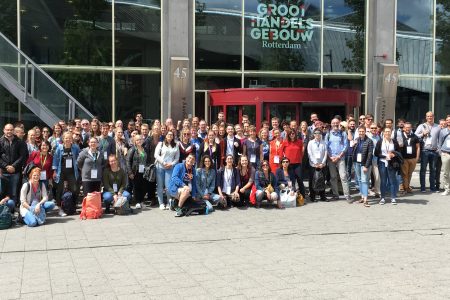Plagiarism please!
The current practice of avoiding academic plagiarism costs millions of dollars per year. By allowing scholars to plagiarize, these costs can be reduced substantially and more scientific progress can be made.
Plagiarism is a serious matter. Various scandals have made the news recently, including two German ministers who were accused of copy-pasting their PhD theses; they resigned from office. Within academia, plagiarism is seen as one of the deadliest sins. Indeed, since plagiarism is defined as an attempt to pass off someone else's ideas as your own, and ideas are what scientists bring to the table, this is very serious. Interestingly, you can also plagiarize your own work. This is called 'auto-plagiarism' and refers to attempts to pass off all or part of your prior work as a new idea. This is generally disliked by journal editors, who select for 'novelty' and 'impact'.
It should come as no surprise, then, that the current practice is always to paraphrase the ideas you refer to, even if they are your own. Although authors are allowed to include literal citations - according to the American Psychology Association this should be done using "quotes" - you might have noticed that this is very rare. Students sometimes include literal quotes in the first version of their bachelor's thesis, but they are promptly instructed to paraphrase those passages instead. The idea is that by re-formulating the ideas of others in your own words you will better understand these theories and arguments, which is of course very commendable in an educational setting.
However, as scholars we also strictly adhere to these norms. Only rarely do academic articles contain literal excerpts, which then usually have only anecdotal value, such as a quote from William James or Albert Einstein. Any serious description of a theory or point of discussion taken from someone else’s work is commonly paraphrased. Why is that?
Consider the example of the 'Simon effect', a well-known effect from cognitive psychology. Four (literal) excerpts from four articles that refer to this effect in their introduction sections are given in the box below.*
As you might notice, these paragraphs are all attempts to describe the exact same effect. The precise phrasing, however, is different each time. Surely, there are slight variations, such as the type of stimuli involved, but the central point made is the same in each excerpt. Indeed, one could easily copy-paste the first paragraph into the other three articles, and no-one would probably notice.
Now, do these authors really understand the Simon effect better because they have paraphrased the original description? Do they still need that? Or is it their egos talking? Maybe we scientists just like our own words better by definition?
Regardless of motive, my point here is this: the current norm among scientists to paraphrase every single idea is a serious waste of time and tax payer's money. I propose we allow ourselves to include literal citations and only adjust the text where absolutely necessary. This has various advantages:
-
Prioritization - Rather than spending time on describing ideas that have already been described by others quite well, you can spend your time on the novel parts of your article. Yes, those parts that you actually contribute to science.
-
Efficiency - Paragraphs can be re-used. One hour of writing now pays off more often than just once.
-
High quality - Researchers no longer need to stare at an extremely elegant and apt description written by someone else and settle for their own inferior versions. Well-written paragraphs can be used again and again.
- Readability - This also offers an advantage with reading articles. Think of all the times you read a paragraph, and only after re-reading it several times does it hit you: it's just the Simon effect (or any other theory or experiment)! The text was so badly written, you just didn't recognize it as such. If the author had used the same literal phrasing you had seen in many articles before, you would have immediately recognized the description. In fact, you can read much faster when entire paragraphs are familiar and you can skim straight to the truly novel parts of the article.
Finally, it seems to me that eventually we simply must adopt a less strict norm on literal citations, in order to save the quality of scientific publications. Consider again the paragraphs describing the Simon effect. There are not that many novel ways one can re-structure these sentences and still produce elegant text. At some point we will run out of well-written phrases but - in order to avoid plagiarism - we would still need to come up with new rephrasings, which however will become worse and worse. Indeed, as more articles are published on a certain topic, the lower the quality of the writing will be, just because authors have to be sure their phrasing is unique. To me that doesn't sound like progress at all...
So, I propose to reinstate the ancient custom of citing passages literally. Everyone who has read Homer's Odyssey will immediately recognize phrases such as "Tell me, Muse, of the man of many ways, who was driven far journeys (…)" as would the common man in ancient times; it was customary to repeat and remember literal paragraphs rather than paraphrasing stories. My feeling is that Homer would have been just fine with that.
Moreover, let us, scientists, not make the mistake of regarding ourselves as such celebrated authors. We read, we theorize, conduct experiments, and only then do we write; and most of our writing is no Pulitzer price material anyway. Claiming ownership of specific combinations of words that are extremely common within our field is just bordering on narcissism. At the same time, when you do write a beautiful, well-phrased paragraph - yes it sometimes just happens - then be proud when your piece of text stands the test of time and is literally part of new publications.
Of course, I am not advocating citing someone else’s work without mentioning this in footnotes or references; credit where credit’s due. However, if your beautifully written paragraph is literally incorporated by author after author, in article after article, I will guarantee you this: there is no need for the reader to check the footnotes, for your paragraph is immediately recognized as a “classic [your name]".
PS. Parts of this text may be cited literally, preferably as often as possible!
*Four (literal) excerpts from four articles that refer to the 'Simon effect' in their introduction sections:
"In a typical Simon task, coloured target stimuli are presented and participants are to react to the colour of the targets by pressing either a left or a right response key. Importantly, targets are either presented to the left or to the right of fixation. One typically observes faster and/or more accurate performance when there is spatial correspondence between the target and the correct response than when there is no such correspondence."
- Beckers, T., De Houwer, J., & Eelen, P. (2002)"In a typical Simon task, participants respond with a left or a right keypress to target colors (e.g., red or green), and horizontal target position varies. In this situation, spatially corresponding conditions (left S–left R; right S–right R) still produce better performance than do noncorresponding conditions (left S–right R; right S–left R), although processing of target position is not explicitly instructed."
- Ansorge, U., & Wühr, P. (2004)"The Simon effect is observed when people perform spatial responses to a nonspatial feature of a spatially varying stimulus. If, for instance, a left-hand response is signaled by a green and a right-hand response by a red stimulus, the left-hand response will be faster if the green stimulus appears on the left side, whereas the right-hand response will be faster if the red stimulus appears on the right side."
- Hommel, B. (2005)"In the typical Simon task, stimuli vary on a spatial dimension (e.g., randomly appearing on the left or right) and on a non-spatial dimension (e.g., having different colors). Participants have to respond to the non-spatial stimulus feature by performing a spatially defined response (e.g., pressing a left or right key). Although the location of the stimulus is irrelevant for the response choice, it nevertheless influences the response time and accuracy. (…) Participants respond faster (and more accurately) when the stimulus location is congruent with the response location than when the stimulus location is incongruent with the response location."
- Haazebroek, P., van Dantzig, S., & Hommel, B. (2013)





